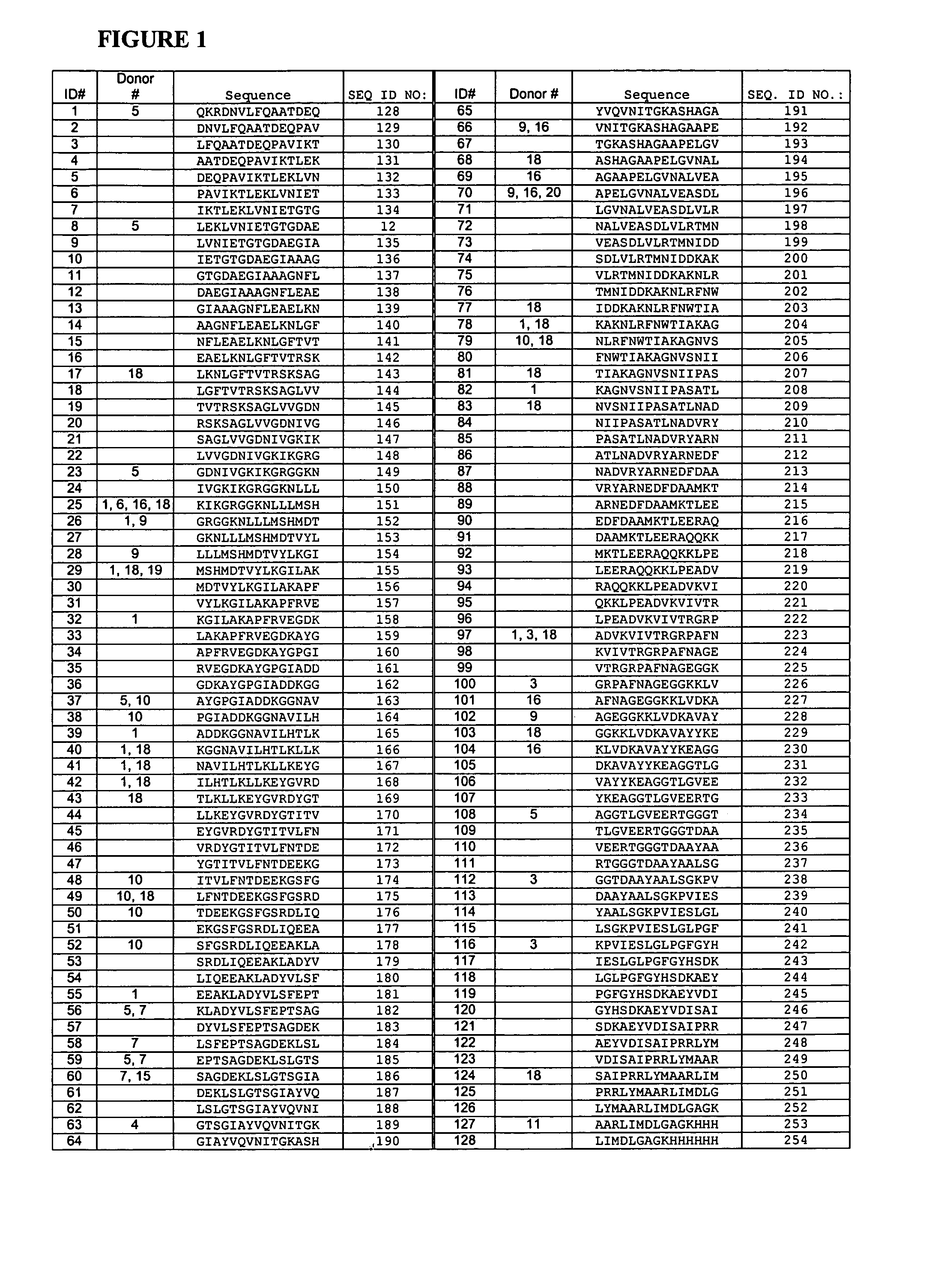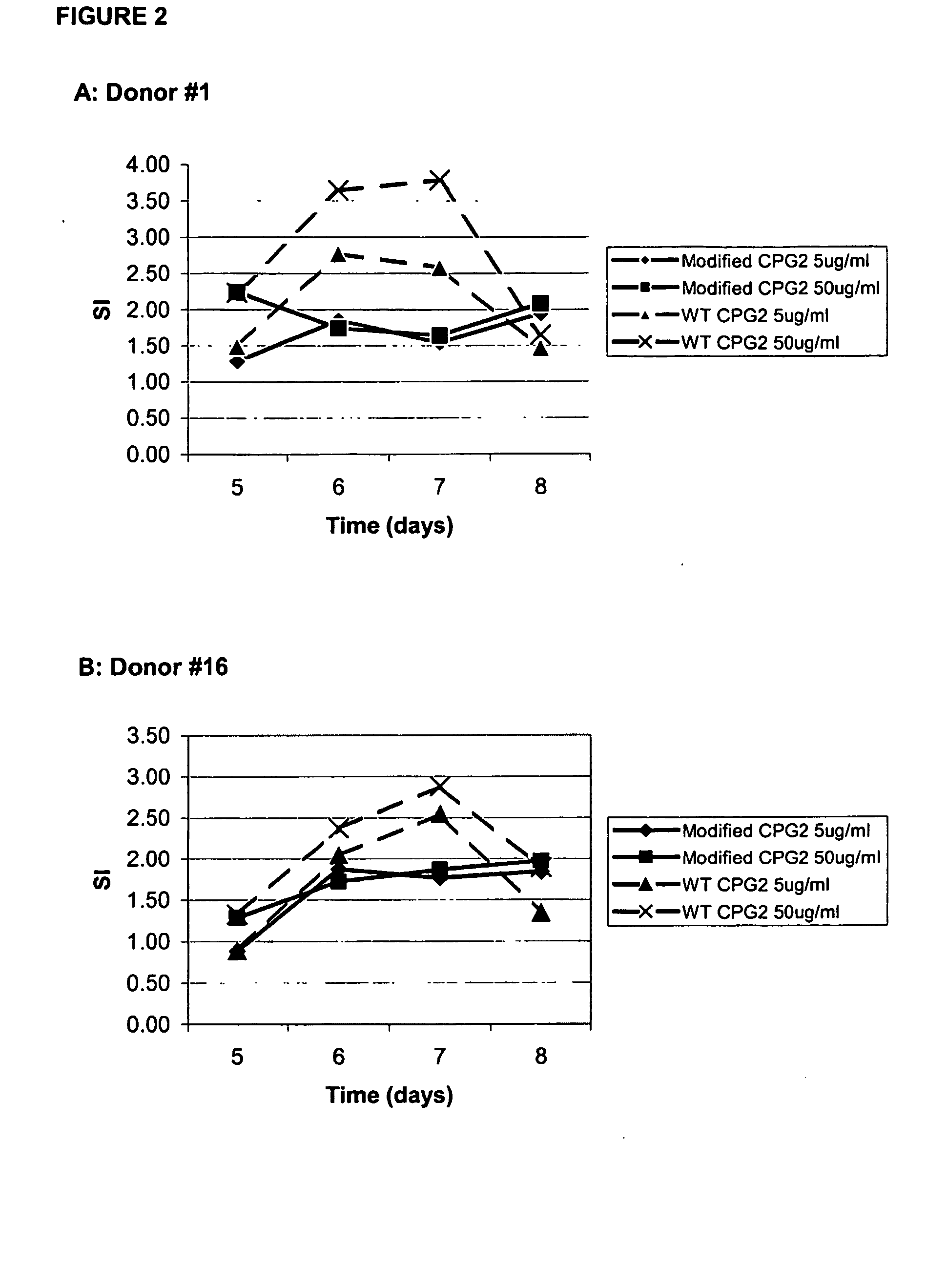T-cell epitodes in carboxypeptidase g2
- Summary
- Abstract
- Description
- Claims
- Application Information
AI Technical Summary
Benefits of technology
Problems solved by technology
Method used
Image
Examples
example 2
[0123] Identification of T-Cell Epitopes Using Synthetic Peptides and Nave Human PBMC In Vitro Proliferation Assays.
[0124] The interaction between MHC, peptide and T-cell receptor (TCR) provides the structural basis for the antigen specificity of T-cell recognition. T-cell proliferation assays test the binding of peptides to MHC and the recognition of MHC / peptide complexes by the TCR. In vitro T-cell proliferation assays of the present example, involve the stimulation of peripheral blood mononuclear cells (PBMCs), containing antigen presenting cells (APCs) and T-cells. Stimulation is conducted in vitro using synthetic peptide antigens, and in some experiments whole protein antigen. Stimulated T-cell proliferation is measured using .sup.3H-thymidine (.sup.3H-Thy) and the presence of incorporated .sup.3H-Thy assessed using scintillation counting of washed fixed cells.
[0125] Donated cells were obtained from the National Blood Service (Addenbrooks Hospital, Cambridge, UK). Ficoll-paque ...
example 3
[0130] Production of CPG2 Gene.
[0131] The original sequence of CPG2 was taken from that of Pseudomonas sp. Strain RS-16 (gene bank accession no. AE002078). The protein sequence of 390 amino acids was back-translated to give a DNA sequences of 1170 nucleotides. Back-translation was done using commercially available software (DNAstar, Madison, Wis., USA) and the sequence compiled based on the most frequently used codons for E. coli. The sequence was used to design a set of 24 synthetic oligonucleotides. The oligonucleotides ranged in size from 50 to 83 nucleotides in length and were designed to have overlapping temini of 19 to 25 nucleotides. The gene was designed also to have an Asc I site at the 5' end and a Sac I site at the 3' end to allow cloning into a plasmid vector. The oligonucleotides are listed in table 7.
11TABLE 7 Synthetic oligonucleotide sequences Name Sequence OL549 CAGAAACGTGACAACGTTCTGTTCCAGGCTGCTACCG-ACGAACA GCCGGCTGTTATCAAAACCCTGGAAAAAC OL550 GAAGTTACCAGCAGCAGCGATAC...
example 4
[0140] Site-Directed Mutagenesis of CPG2 Gene
[0141] The cloned active CPG2 gene was used as a template for the development of mutated variants of the gene using the QuickChange.TM. Site-Directed Mutagenesis Kit (Stratagene, LaJolla, Calif.). A high fidelity thermostable polymerase is used to extend pairs of oligonucleotide primers, which are complementary to opposite strands of the vector and contain the desired mutation. Incorporation of the primers results in a mutated vector containing staggered nicks. Parental DNA is digested using DpnI endonuclease which is specific for methylated and hemimethylated DNA and the nicked vector DNA incorporating the desired mutations is then transformed into competent E. coli cells. Sixteen pairs of oligonucleotide primers designed to introduce a point mutation each in the template, were used. Oligonucleotide sequences are shown in Table 8.
13TABLE 8 Oligonucleotide primers used to introduce mutations to the CPG2 template gene. The sequence, length...
PUM
| Property | Measurement | Unit |
|---|---|---|
| Temperature | aaaaa | aaaaa |
| Temperature | aaaaa | aaaaa |
| Temperature | aaaaa | aaaaa |
Abstract
Description
Claims
Application Information
 Login to View More
Login to View More - R&D
- Intellectual Property
- Life Sciences
- Materials
- Tech Scout
- Unparalleled Data Quality
- Higher Quality Content
- 60% Fewer Hallucinations
Browse by: Latest US Patents, China's latest patents, Technical Efficacy Thesaurus, Application Domain, Technology Topic, Popular Technical Reports.
© 2025 PatSnap. All rights reserved.Legal|Privacy policy|Modern Slavery Act Transparency Statement|Sitemap|About US| Contact US: help@patsnap.com


